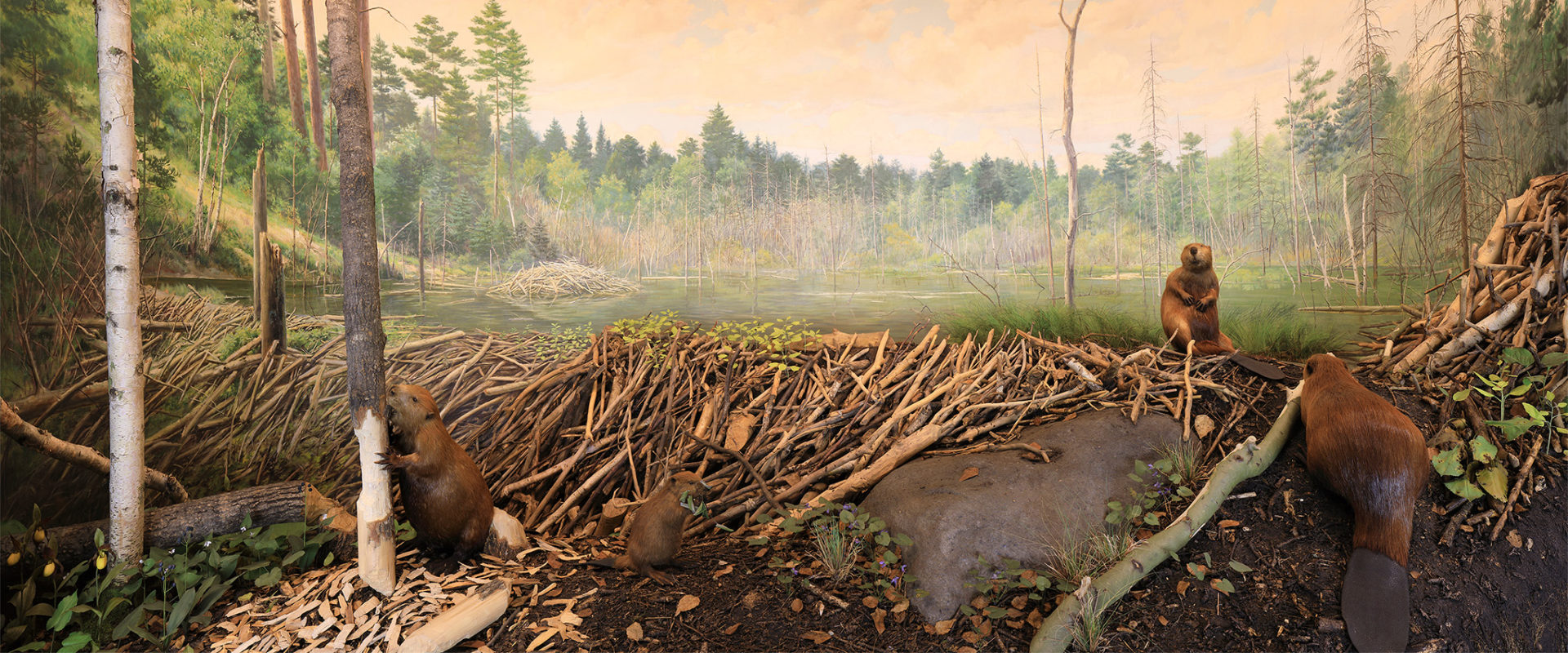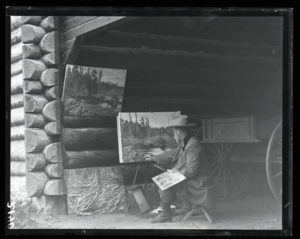
Diorama Spotlight: Beavers at Lake Itasca
Published05/14/2020 , by Amber Kastner, public science events manager
At the headwaters of the Mississippi River, Itasca State Park stands as a vibrant reminder of the diverse biomes throughout Minnesota. In this special place, old growth red and white pine forests tower over bogs and lakes, eventually giving way to prairie grasslands. Water shapes this region, and streams running throughout help create rich habitat and alter the landscape. But there are also other architects helping reshape the park’s terrain. Natural engineers have removed the trees and constructed large dams that block the flow of water, creating expansive ponds. Intricately adapted for life in the water, the beavers living here have built a world that allows them to thrive.
Completed in 1919, the Beavers at Lake Itasca diorama is the oldest in the current Bell Museum. After beginning its history in the Zoology building at the University of Minnesota, it was moved in 1940 to the former Bell Museum on Church Street before being transferred once more to its current location. In preparation for the move to its new home in 2017, it was revealed that the color of the pond and background painting had been altered during the first move. The transition to the current Bell Museum space provided the perfect opportunity for skilled artisans to restore the diorama to its original condition and color tone.
We are now able to see the vision of Charles Corwin, a Field Museum artist and prominent diorama painter of the early 1900s. It was in June of 1917 that he traveled to Itasca State Park to live at the University’s Forestry School while preparing sketches and paintings of the beavers and dam at Nicollet Creek. His preparation was thorough, and when he returned to Minneapolis to begin painting the background he had a detailed image in his mind. It is said that he painted in a continuous line, moving from left to right without going back to make alterations or touch-ups.

Charles Corwin spent several weeks at Itasca State Park in June 1917 painting preparatory sketches that captured the expansive landscape and detail of the beaver dam.
At the time of its creation, the beavers at Lake Itasca were of particular interest to scientists. There are few things more synonymous with the westward expansion of the United States than the fur trade and by 1900, the beaver population in Minnesota was nearly gone. In 1901, three beavers from Ontario were reintroduced into the park and protected from trapping. By the time work on the beaver diorama began in 1917, the local population had rebounded significantly.
Today, beavers thrive throughout a large range that covers most of Canada and the United States. With their webbed feet and large flat tails, beavers are excellent swimmers and can stay underwater for up to 20 minutes. Their fur consists of a thick undercoat that provides warmth and long guard hairs on top that shield them from the water. The family structure depicted in the diorama demonstrates how a team of builders is able to significantly alter the landscape around them. Members of the rodent family, beavers have sharp teeth that are the perfect tool for felling deciduous trees (like ash, aspen, and willow) and consuming their bark, branches, and leaves. The construction of a dam and lodge with those fallen trees creates both a large flooded area and dry home to protect the beavers from predators and seasonal change. While this activity may seem destructive, the ponds that beavers create support an abundance of species and increase ecological diversity in the area.
Location: A stream that feeds into Lake Itasca in Itasca State Park, Clearwater County, Minnesota
Biome: Located in the transition zone between old growth pine forest and prairie grasslands
Season: Late spring / Early summer
Date completed: 1919
Dimensions: 10’x 20’
Background artist: Charles Corwin
Foreground artist: Jenness and Olive Richardson
Restoration 2017: Midwest Art Conservation Center, Chase Studios, Museum Professionals, and Split Rock Studios
Donors: The friends of Thomas Sadler Roberts – founding donor, Diorama Legacy Society – restoration donor







